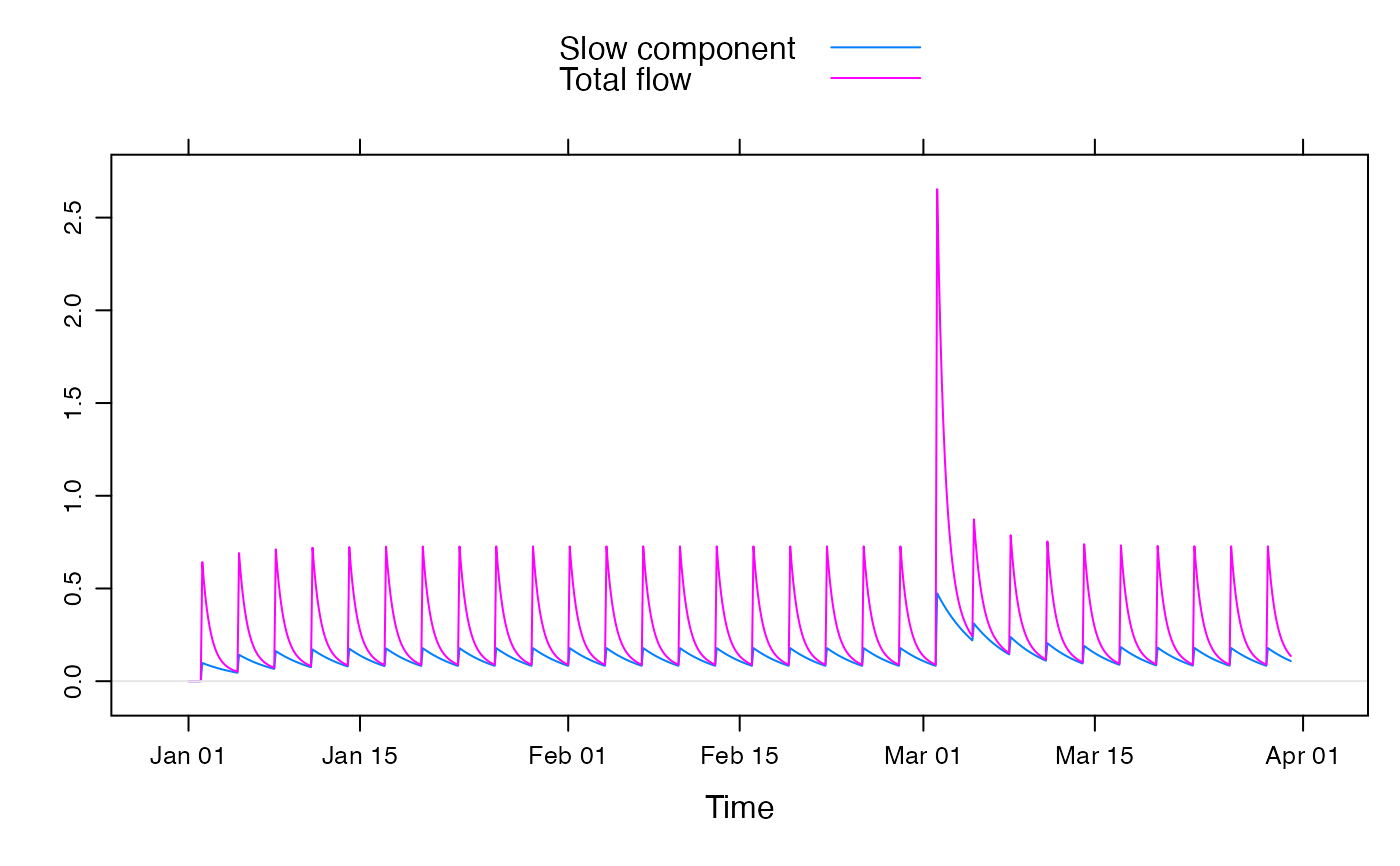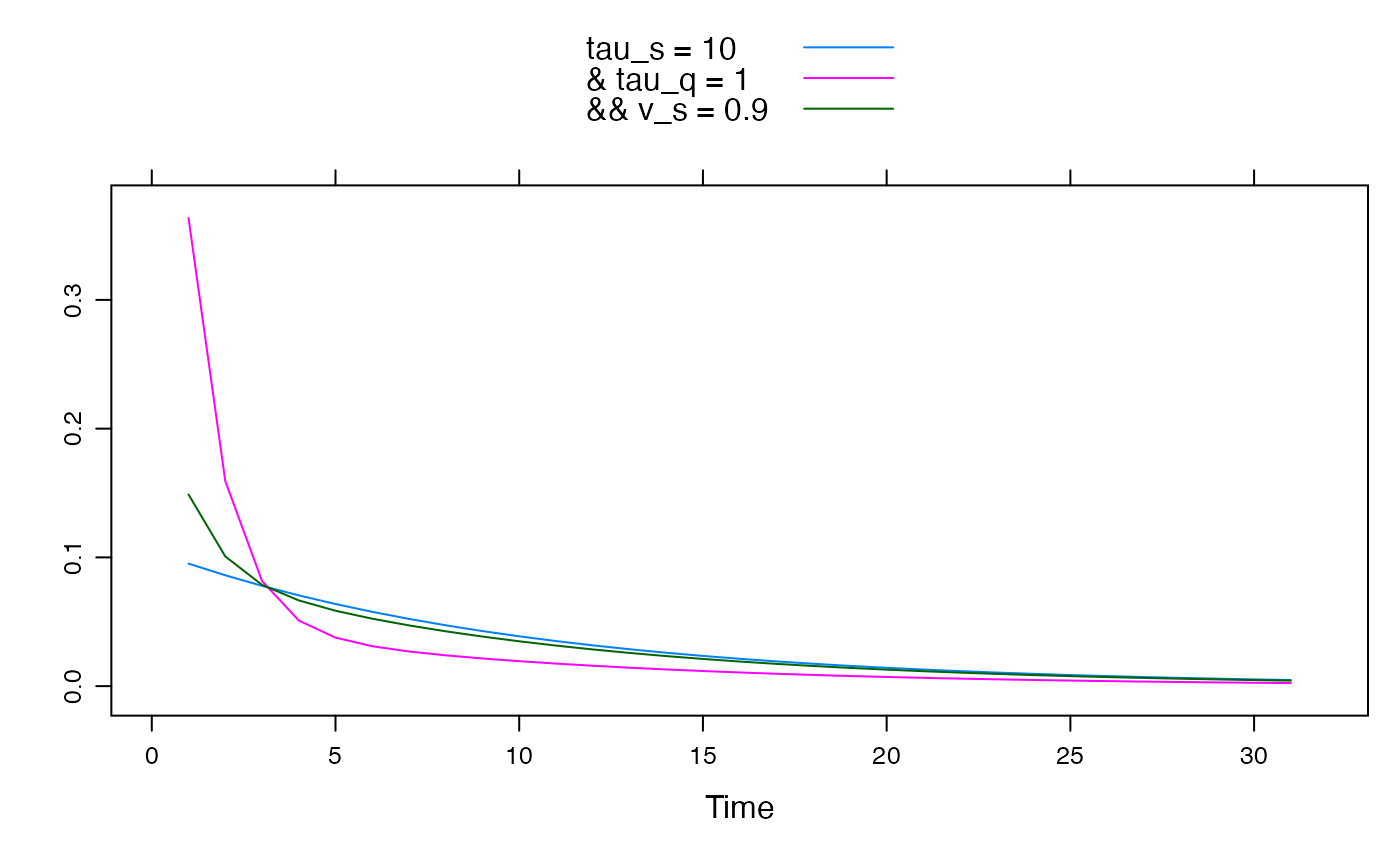A unit hydrograph (linear transfer function) defined as a system of exponentially receding components. Each component is defined by its time constant and fractional volume, and if there are multiple (up to 3) such components they may be in a parallel and/or series configuration.
expuh.ls.fit(
DATA,
order = hydromad.getOption("order"),
delay = hydromad.getOption("delay"),
quiet = FALSE,
...
)Arguments
- DATA
Placeholder
- order
Placeholder
- delay
Placeholder
- quiet
Placeholder
- ...
Placeholder
Value
the model output as a ts object, with the same
dimensions and time window as the input U. If
return_components = TRUE, it will have multiple columns named
Xs, Xq and, if relevant, X3.
Details
The expuh model is a transfer function translating an input time
series U into an output series X. It describes a configuration
of exponentially decaying components, each defined by a recession rate
\(\alpha\) and peak response \(\beta\). However, in hydrology these
parameters are more easily interpreted in terms of time constants \(\tau\)
(number of time steps to reduce to a fraction \(1/e\), 37%) and
fractional volumes v. These are directly related as:
$$\tau = -1 / \log(\alpha)$$
$$v = \beta / (1 - \alpha)$$
If there are two components in parallel, these are conventionally called slow (s) and quick (q) flow components. The total simulated flow X is the sum of these; \(X[t] = X_s[t] + X_q[t]\), and:
$$X_s[t] = \alpha_s X_s[t-1] + \beta_s U[t]$$ $$X_q[t] = \alpha_q X_q[t-1] + \beta_q U[t]$$
Two components might also be arranged in series rather than parallel, in which case:
$$X_s[t] = \alpha_s X_s[t-1] + \beta_s U[t]$$ $$X[t] = \alpha_q X[t-1] + \beta_q X_s[t]$$
This configuration is specified by the argument series = 1. The
default series = 0 specifies all components to be in parallel.
In the case of three components, with corresponding time constants
\(\tau_s\), \(\tau_q\) and \(tau_3\) (tau_s, tau_q, tau_3),
there are four possible types of configuration:
- list("series = 0")
all 3 components in parallel, i.e. independent flows: X = s + q + 3. In this case
v_qdefaults to1 - v_s - v_3in order to ensure that the total volume is 1.- list("series = 1")
one component in parallel with two in series: the
qcomponent is in series with the3component, and thescomponent is in parallel: X = (q * 3) + s. In this casev_qdefaults to 1.- list("series = 2")
two components in parallel with one in series: the
sandqcomponents are in parallel and the3component is in series: X = 3 * (s + q). In this casev_qdefaults to1 - v_sin order to ensure that the total volume of the parallel component is 1. The total volume will be 1 ifv_3is also 1.- list("series = 3")
all 3 components in series: X = s * q * 3. In this case
v_qdefaults to 1. The total volume will be 1 ifv_sandv_3are also 1.
References
Jakeman, A.J., I.G. Littlewood, and P.G. Whitehead (1990), Computation of the instantaneous unit hydrograph and identifiable component flows with application to two small upland catchments, Journal of Hydrology, 117: 275-300.
See also
Examples
data(HydroTestData)
mod1 <- hydromad(HydroTestData,
routing = "expuh",
tau_s = 30, tau_q = 5, v_s = 0.5
)
flowcomps <- predict(mod1, return_components = TRUE)
xyplot(cbind(
`Slow component` = flowcomps[, "Xs"],
`Total flow` = flowcomps[, 1] + flowcomps[, 2]
),
superpose = TRUE
) +
latticeExtra::layer(panel.refline(h = 0))
 U <- ts(c(1, rep(0, 30)))
xyplot(cbind(
"tau_s = 10" = expuh.sim(U, tau_s = 10),
"& tau_q = 1" = expuh.sim(U, tau_s = 10, tau_q = 1, v_s = 0.5),
"&& v_s = 0.9" = expuh.sim(U, tau_s = 10, tau_q = 1, v_s = 0.9)
),
superpose = TRUE
)
U <- ts(c(1, rep(0, 30)))
xyplot(cbind(
"tau_s = 10" = expuh.sim(U, tau_s = 10),
"& tau_q = 1" = expuh.sim(U, tau_s = 10, tau_q = 1, v_s = 0.5),
"&& v_s = 0.9" = expuh.sim(U, tau_s = 10, tau_q = 1, v_s = 0.9)
),
superpose = TRUE
)
